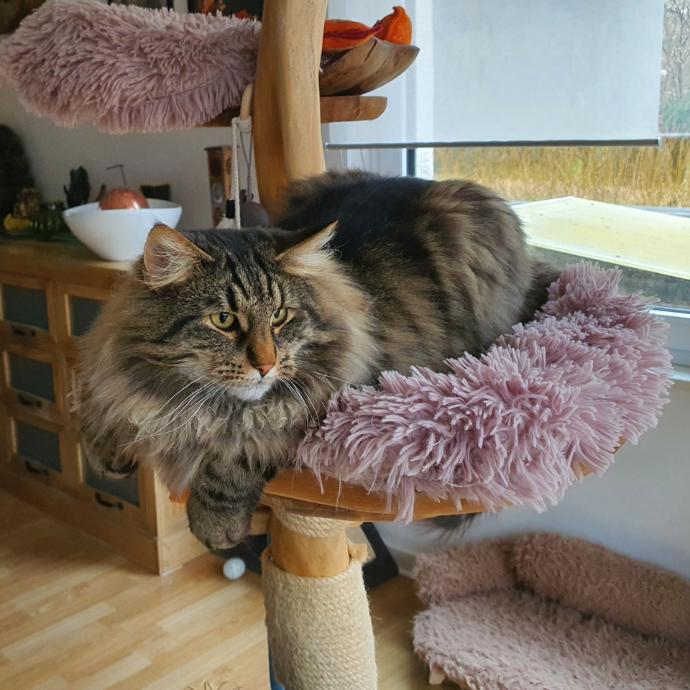
The Norwegian
The Norwegian Cat, or Norwegian Forest Cat (Norsk Skogkatt in Norwegian), is one of the oldest cats. It is part of the history of Scandinavia.
According to Scandinavian mythology, Freyja, the goddess of love and fertility, had a chariot drawn by two large and powerful cats. Thor was challenged by Loki to lift a cat but failed. It is also mentioned in children's stories where it is described as a "fairy-cat" who performs miracles for its very poor master. We find its traces at the time of the Vikings, who would have brought cats aboard their longships to protect their cargo from rodents.
The Norwegian cat has lived in the wild for a long time in the Norwegian forests and has evolved naturally to adapt to the harsh climatic conditions of Norway. It was not until the 1930s that its breeding began but the breed was not recognized until 1972.
The Norwegian cat is a large cat with semi-long hair and a robust look. Its head is triangular in front with a straight profile, wide ears at the base and placed in the extension of the triangle of the head. Lynx-tips are much appreciated. His eyes are large, well opened and set obliquely. His expression should be alert and wide awake. Its body is long and massive with a robust boning and a broad chest. Its tail is long, bushy, carried erect and should reach the base of the neck. Its semi-long fur is composed of a woolly undercoat, covered with shiny and waterproof semi-long hair. It requires regular brushing, even daily during moulting. The undercoat forms panties at the back of the thighs. The Norwegian has a beautiful heart-shaped collar which starts from the back of the ears and extends over the throat. The coat of the Norwegian can be: black (brown), blue, red, cream, amber, tortie, plain, tabby, with smoke or silver, with or without white.
The Norwegian cat is a cat that has endurance, strength and an enormous capacity for adaptation. He lives as well in a family with many children as with a single person. He is an intelligent cat, always ready to make the most of every situation. This is why he supports his congeners, dogs and other domestic animals. The Norwegian cat is very close to its guardians and very affectionate. He likes interactions, he needs to participate in everyday life, to stimulate his curiosity, to play. If he adapts very well to life in an apartment, he must be provided with something to exercise, jump, such as a cat tree, a 3-dimensional course or a secure exterior.
Thanks to its rustic origins, the Norwegian cat is generally a healthy cat without any particular fragility. Nevertheless, there are some genetic diseases:
- GSDIV: disease that disrupts glucose metabolism
- PKD: hereditary disease which causes kidney problems. Large, irregular cystic kidneys can be identified by ultrasound before clinical signs appear
- PKDEF: hemolytic anemia caused by insufficient pyruvate kinase activity that leads to instability and loss of red blood cells
- HCM: a syndrome characterized by abnormal thickening of the walls of the heart. HCM can be of congenital or hereditary origin but also of secondary origin. It can develop at any age.
These genetic diseases can be detected by DNA testing for GSDIV and PKDEF, by ultrasound for PKD and HCM. In principle, breeders should perform these screening tests and should exclude affected cats from breeding. Don't hesitate to ask for test results!